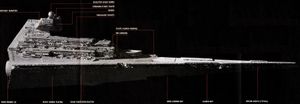|
|
| (One intermediate revision by the same user not shown) |
| Line 115: |
Line 115: |
| {{clear}} | | {{clear}} |
|
| |
|
| | | [[Category:Former Taldryan starships]] |
| {{TalOOB}}
| |
| [[Category:Taldryan OOB|Resurgent]] | |
| [[Category:Taldryan Navy]]
| |
| [[Category:Taldryan Military Reconstruction]]
| |
Latest revision as of 18:04, 20 December 2016
- "Sir, the odds of surviving a direct assault on an Imperial Star Destroyer—"
- ―C-3PO to Han Solo
The Imperial II-class Star Destroyer, also known as the Imperial II-class Destroyer and colloquially the "ImpStar Deuce", was a Star Destroyer model that was derived from the Imperial I-class Star Destroyer.
Characteristics
 Imperial II sideview with notable features highlighted.
Imperial II sideview with notable features highlighted.
- "Have you ever seen what a Star Destroyer can do to the surface of an unshielded planet? Stones run like water and sand turns to glass."
- ―Carnor Jax to Mirith Sinn.
Several differences existed between the Imperial I and Imperial II-class Star Destroyer, including the replacement of the tractor beam targeting array between the command tower's sensor globes with a communications tower, as well as the removal of point defense weaponry.
The Imperial II was built with a heavily reinforced hull, stronger deflector shields, and greater firepower than the original Imperial I class. The prominent quad heavy turbolaser and heavy ion cannon turrets flanking the surface of the Imperial I-class Star Destroyer were also replaced with batteries of eight-barreled turbolasers or ions in unarmored barbette mountings. Another new feature included two parallel "claws" for grappling smaller starships placed in the ventral secondary docking bay.
The Imperial II-class Star Destroyer was not without problems. The Errant Venture, formerly the Virulence, was continually breaking down due to lack of maintenance. During the height of the Rebellion, an Alliance Special Operations man said that the Star Destroyer had 174,000 design flaws waiting to be exploited.The command deck was also a vulnerability, as the ship's operations were coordinated there.
Despite these flaws as well as the vast resources required to maintain and crew the vessels, they nevertheless remained formidable front line units, even when compared to more efficient and modern designs such as the Nebula-class and Turbulent-class Star Destroyers.
The Imperial II-Class Star Destroyer, the upgrade to the hugely successful Imperial I-Class, represents one of the pinnacles of warship design in the galaxy, and virtually none that have had as much of an impact. The Imperial II class is the measuring stick to which all other warships are compared to.
The Imperial II is designed to be a self-contained fleet of its' own, as well as operate effectively in larger fleet-wide roles. Often, a single Imperial II is enough to pacify a system or keep the peace, and in fact is often designated as a peacekeeping battleship. Widely deployed by first the Galactic Empire and then by the latter governments that took over, it still remains as effective as ever despite the introduction of newer warships.
History
Complement & Assignment
Ship Commander
TBA
Attached Vessels
The Redemption plays host to a number of Squadrons of Starfighters, and a complement of support vessels as well.